

One dominant mode in the popular culture in the last nineteenth century was thus the tendency to inclose reality in manageable forms, to contain it within a theatrical space, an enclosed exposition or recreational space, or within the space of the picture frame. If the world outside the frame was beyond control, the world inside of it could at least offer the illusion of mastery and comprehension.1
| Dedication ceremonies typically began with a parade through the streets that ended up at the monument. Yet, the parade really began with what one program calls the "assembling of the hosts".2 A small town dedication was likely to draw several thousand people as late as the 1890's and the first decade of the twentieth century.3 The programs describe the excitement of the event, as the town swelled with visitors coming in by carts and buggies, wagons and railway. The assembling climaxes with the arrival of uniformed troops and veterans and with the arrival of such esteemed individuals as the Governor or a high ranked and well known veteran. That the programs begin their descriptions of the dedication with such accounts of assembly reveal that the ceremony of the dedication transcended the dedication site and speeches. Rather, it was a large scale event in both time and space. With its size, preparations, and activities, it involved the whole town for such an extended period of time as to make it a veritable reenactment of the past, a virtual reality. |
| The parade consisted of soldiers and veterans often representing different camps, states, or regiments of the old Confederate army. They would march in uniform, bearing regimental battle flags. The troops were led by a notable figure such as the Governor or a highly renowned veteran. This parade of marching, uniformed soldiers and Confederate flags can only be described as a drama. It suggests an effort to not merely remember the past, but to recreate it. | 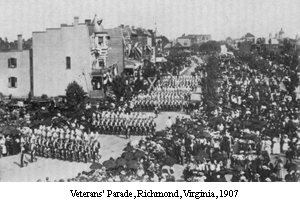 |
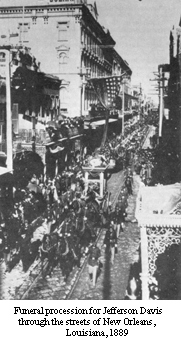 |
The parade also celebrated the symbols of the Confederacy. The towns were decked with the
stars and bars as well as the stars and stripes. In one case, the dedication displayed photographs
of Davis, Jackson, and Lee. In the small town of Luray, Virginia, the parade included eleven
ladies representing the Confederate states who "marched from the float to the monument in the
same order in which the Southern States seceded from the
union."4 Regiment bands would play
"Dixie" and other favorites such as "The Bonnie Blue
Flag both in the
parades and as part of the dedication ceremonies, interspersed among prayers, poems, and
orations.
Despite the great size of the assembly, the dedication had a decidedly domestic air about it. This was primarily achieved through the inclusion of women and children in the ceremonies and their presence in the audience. Women marched in the parades and played a crucial and highly respected and appreciated role as benefactresses of the entire events. The typical program expresses much gratitude to the tireless women of the South who were responsible for the preparations and arrangements that made the day possible. |
| Women were also present at the dedication as representatives of womens' organizations, most commonly The United Daughters of the Confederacy, which were often the groups to have originally conceived of the monument, to have raised the funds for it, chosen the artist or design, and taken care of other such fundamental details of the project. However, though women were given their place in these dedications, their place was never confused with that of men; women rarely spoke at these ceremonies and were certainly never given the role of orator. | |
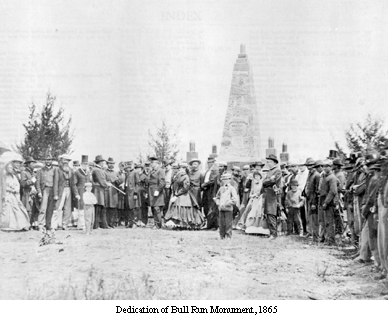
| Children might also march in the parades. They were often the source of musical fare and might be counted on from time to time to unveil the monuments, marking the end of the dedication ceremonies. The audience, too, was sure to include men and women, young and old alike. Orators emphasized the multi-generational character of their audiences by addressing them as boys and "maidens", men, women, and "old boy" veterans. The Confederate dead, too, would be referred to as boys or "old boys". Thus, the soldiers of a lost South were given a special place in the domestic structure of the New South. | 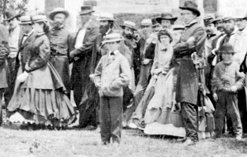 |
| The multi-generational quality of the dedications' audience and participants was essential to perpetuating the cause through the activity of memory. Speakers often appealed directly to children and parents, informing them of the importance of passing memories on to children as a way of sustaining The Cause and The Old South. The dedication ceremonies themselves were effective means of teaching children to remember and revere those soldiers of a lost South. These soldiers were represented by the presence of veterans and the recollections of an older generation repeated again and again like a sacred rite in speeches and poems at any given dedication. Wilson has refered to these memories as a kind of creation myth, repeated in ceremony and creating a regional identity.5 | |
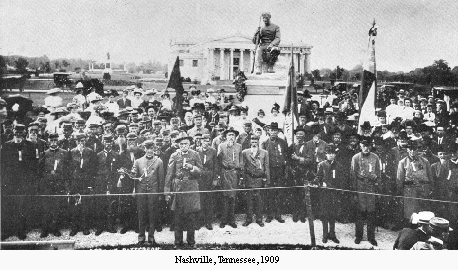
| The multi-generational character of the dedications also affirmed the structure and virtues of domesticity. This was achieved by including women and children and simultaneously affirming the authority of men by celebrating them and, with few exceptions, only them in the sculpture of the monument. Men, usually Confederate dead or Confederate veterans and heros, were also the main objects of celebration in addresses and poems. Finally, men were celebrated as respected soldiers, orators, and politicians through their presence at the dedications and their role of facilitating and presiding over its ceremonies. As will be seen in the section on speeches, women, too, were celebrated in speech and poems, and given a place of respect through an integral role in the dedication ceremonies. Nevertheless, an important distinction is to be made. Women were celebrated as domestic figures, essential to the stability of the home, of the men of the South, the perpetuation of memory, and the entire South, itself the greatest home. Men were celebrated as public figures, leaders. However much the women did to make the monument and dedication possible, it was men who presided over the public ceremonies of the dedication. This clearly relegated women to a facilitory, domestic role and empowered men. Thus, dedications were highly gendered public spheres which sought to affirm the stability of a domestic and ordered South. |
| With its parade and its Confederate symbols, the dedication was an intense, collective drama in which everyone played a part. Like White City, the dedication celebrations and ceremonies engulfed the individual by virtue of the size of its crowds and the public stage (the streets, the cemetery, the court-house lawn) on which they took place. The dedications, like White City, teach that to be in public means to be surrounded and engulfed by one's environment. The dedication drama is a lot like the spectacle of the metropolis or the World's Fair in that way. It dazzles the spectator's every sense through a production much larger than the individual, seemingly beyond his or her control. | 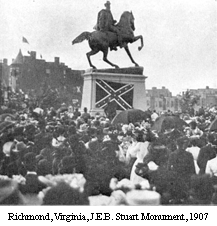 |
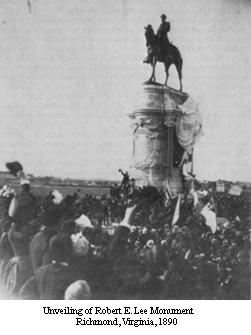 |
The dedication differs from spectacle in that the individual plays a more participatory role in the drama than he or she does in the mechanized spectacle of the metropolis or the elitist White City. Unlike the spectators of White City, the audience members of the dedication were partial creators of the ceremonies. For, the ceremonies drew on the symbolic and emotional power of the crowd. Furthermore, the foundation of the dedications was the activity of memory. The audience was needed to bare witness to the monument and the ceremonies, and thus to the Old South in order to perpetuate its memory. This remembering, in a sense, was the true purpose of any monument dedication. Additionally, by celebrating the South, monuments and their dedications celebrated the audiences themselves who were the South. This was reflected in the way in which the ceremonies were not limited to the site of the monument but spilled out into the streets of the town. In fact, the dedication would often end as it began, with a parade. The processional parade would gather in the streets, the most public of spaces, and make its way to the monument where it would come together to share in collective memory and emotion. It would then recess back into the streets and disperse. Thus, the whole dedication activity seemed to begin and end with the public. |
Despite the differences between the dramatic spectacle of the dedications and the spectacle of
White City, they shared the modus operandi of imitation. Dedications, like White City, revealed
themselves as spectacle, as imitation. For, while the soldiers and veterans appeared in uniform
at Suffolk, Virginia, they were reviewed by Governor Fitzhugh Lee and not General Robert E.
Lee. That the Governor should be General Lee's nephew speaks to the desire and success of the
South to perpetuate its cause and heritage. But, the Governor is not the General, and the change
in command denotes a change in purpose. The army's loyalty is no longer to an independent
Confederate nation, but an incorporated South. The nostalgiac gesture of
reviewing the troops only draws attention to this difference. Furthermore,
such celebrations and ceremonies
only occured on special days and in special places set aside as exceptions to every day reality.
Foster writes:
The parade clearly demarcated a break in the normal sequence of time, and the festive gathering created a sense of community that, being outside the normal order of things, transcended the usual social and economic divisions of society.6Dedications created a virtual reality which presented itself as virtual, by virtue of its being sacred, temporary, and separate in space and time. Yet, this should not detract from the sense that these dedications were, like White City, also meant to give order to reality. The reality created at the dedications may have been, in a sense, virtual, but the lessons that they taught, and the emotions and memories they created were real. |
|
| |
|
|
|
|
|
|
|